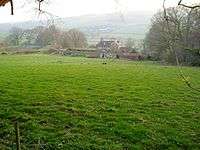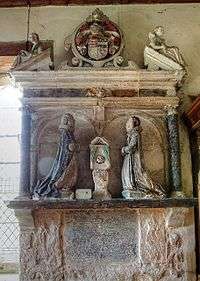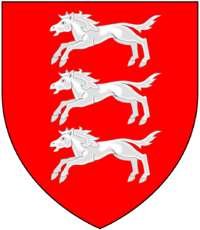Yarty



Yarty is an historic estate in the parish of Membury in Devon, and was from the 14th century intil 1726[2] for many centuries the principal seat of the Fry family.[3] It takes its name from the River Yarty[4] which flows near or through the estate. During the reigns of King Richard II (1377-1399)[5] or King Henry IV (1399-1413)[6] William (or John[7]) Fry inherited the estate by marriage to the sister and heiress of Simon de Yarty,[8] who died without progeny. The mansion house was "newly builded and augmented"[9] by Nicholas Fry (d.1632), Sheriff of Devon in 1626, whose mural monument survives in the Yarty Chapel in Membury Church.[10][11]
The following text appeared in "Report & Transactions of the Devonshire Association Vol 39 (1907)" p. 134:[12]
- "The old house was burnt down between fifty and sixty years ago. Terraces, gardens, and fishponds can still be traced, and at the top of a flight of stairs in the present garden is a
horse's head, the crest of the Frys, carved in stone. Local
tradition says that after "Squire Fry" — the last of his race, I believe — was buried the funeral party upon returning home found him sitting in the chimney corner ! He was " conjured " into the withy bed, whence he was " condemned to go back at the rate of a 'cock's stride' each year"! Where he is now I do not know, but a version of the story states that when the house was burnt down the dove-cot remained untouched, for the "Squire" was there! But here the wing of the popular imagination droops, and what became of him when the dove-cot was finally pulled down is not recorded!"
The story of the ghost returning home "at the rate of a cock's stride each year" also occurs in Devon in relation to Dowrich an historic estate in the parish of Sandford.
Fry family
The Frys of Yarty claimed descent from John of Gaunt, 1st Duke of Lancaster, a younger son of King Edward III. This is apparent from the inscription on a Fry monument in Membury Church as follows:[13]
- In memory of Robert Fry of Yearty Esq who married Frances ye daughter of Joseph Langton of Newton Park in ye county of Somersett Esqre by whom he had issue a sone and 3 daughters who died young and Elizabeth who was married to John Lord King E---n of Ockham she died 23 Jan 1733 Ae 23 who lieth also here interred without issue. Ye said Robert Fry descended from John Fry of Yearty Esq and Agnes his wife ye only daughter and heiress of Yearty of Yearty Esq and which said John was son of John Fry of Feniton Esq and Jane daughter of Edmond Duke of Somersett ye grandson of John of Gaunt, Duke of Lancaster who was ye son of King Edward the Third".
Edmund Beaufort, 2nd Duke of Somerset, KG, was slain at the first Battle of St. Albans on 22 May 1455. By his wife, Eleanor Beauchamp, he had a total of nine children. Their five daughters were co-heirs to their brother, Edmund Beaufort the younger, who died on 4 May 1471, after the Battle of Tewkesbury.[14] A brief biography of Joan (or Jane) Beaufort, a daughter of Duke Edmund and Eleanor Beaufort, is contained in the Complete Peerage, vol.6, 1926, pp. 604–605, under Howth.
The family's historian Edward Fry (1903) disputed this royal descent, stating:[15]
- "How it came to be stated in such a bold fashion that a John Fry married Joan or Jane Beaufort I cannot well make out. It is beyond dispute that it was a Richard Fry who married her, as can be proved by his will and certain Privy Seals of which I have copies; and there is nothing I have yet come across to prove that the said Richard Fry was connected in any way with this Devon family Fry of Yarty".
The American genealogist Douglas Richardson[16] concurs and states that the will of Richard Fry (not John Fry) survives, dated 21 June and probated 19 October 1504. No such royal ancestry is listed in the Heraldic Visitations of Devon.[17] The accepted facts concerning Lady Joan Beaufort (d. 11 August 1518), are that she married firstly Robert St Lawrence, 3rd Baron Howth and secondly Sir Richard Fry.
Further reading
- The Mirror of Literature, Amusement, and Instruction, Volume 2, 11 November 1843, pp. 309–11 "Membury Church" (refers to Yarty throughout as "Tarty")
- Fry, Edward A., Fry of Yarty, published in Proceedings of the Somersetshire Archaeological and Natural History Society, vol.49, 1903, pp. 65–70
References
- ↑ See below "Report & Transactions of the Devonshire Association Vol 39 (1907)" p.134
- ↑ Death of Robert Fry in 1726, per Vivian, p.376; Risdon, p.266, states 1722
- ↑ Vivian, Lt.Col. J.L., (Ed.) The Visitations of the County of Devon: Comprising the Heralds' Visitations of 1531, 1564 & 1620, Exeter, 1895, pp.375-7, pedigree of Fry of Yarty
- ↑ Risdon, Tristram (d.1640), Survey of Devon, 1811 edition, London, 1811, with 1810 Additions, p.21; Pole, Sir William (d.1635), Collections Towards a Description of the County of Devon, Sir John-William de la Pole (ed.), London, 1791, p.118
- ↑ Risdon, p.21
- ↑ Pole, p.118
- ↑ Risdon, p.21 states "William Fry", Vivian, p.375 states "John Fry
- ↑ Pole, p.118
- ↑ Pole, p.118
- ↑ Pevsner, Nikolaus & Cherry, Bridget, The Buildings of England: Devon, London, 2004, p.567
- ↑ See image
- ↑
- ↑ Fry, Edward A., Fry of Yarty, published in Proceedings of the Somersetshire Archaeological and Natural History Society, vol.49, 1903, pp.65-70
- ↑ Douglas Richardson
- ↑ Fry, Edward A., Fry of Yarty, published in Proceedings of the Somersetshire Archaeological and Natural History Society, vol.49, 1903, pp.65-70
- ↑ http://archiver.rootsweb.ancestry.com/th/read/GEN-MEDIEVAL/2007-06/1181062161
- ↑ Vivian, p.375